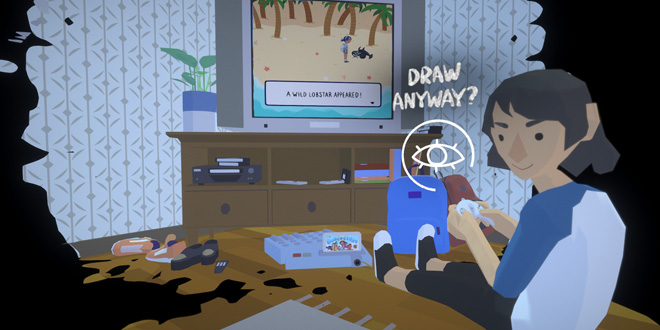 Oliver Lewin, game director for GoodbyeWorld Games, tells Vince Pavey about the challenges of creating a video game controlled by blinking, as well as updating it for PSVR2.
Oliver Lewin, game director for GoodbyeWorld Games, tells Vince Pavey about the challenges of creating a video game controlled by blinking, as well as updating it for PSVR2.
Before Your Eyes is a beautiful, tense and occasionally distressing game in which your own real-life blinks can move forward the passage of time. Its players live through the story of Benny Brynn, as they encounter the people, places and moments that ultimately made up his brief time on Earth.
The game is framed by a conversation with a Ferryman, who explains that what you see will determine whether there is enough of a case for Benny to get into the VIP section of the afterlife or not. … No pressure, then.
“It’s a story about the expectations we place upon ourselves and our fears of falling short of them,” explains the game’s director Oliver Lewin, who has been with the project since very early on, and was responsible for a lot of the game’s update posts on Kickstarter throughout its somewhat lengthy development.
If you’re unfamiliar, Before Your Eyes started out as Close Your in 2014, a game with a very similar concept and usage of camera tech which was successfully crowdfunded two years later. As its scope, budget and team grew, it went through several iterative changes, and even another title — Coda — before it was finally released to audiences in 2021 as the game we’re more familiar with today. But before all that — where did the core concept come from? “As a college student, Will Hellwarth started the project and originated the idea for the central mechanic of players’ blinks causing time to move forward,” recalls Lewin. “Seeing facial detection start to become commonplace in mobile apps at the time, I think he realised, ‘Why not use this in a meaningful interactive way?’
“Not just for the novelty, but in a poetic sense, because blinking is linked so harmoniously with time passing – like an editing technique. Soon after, Graham Parkes, our lead writer and creative director, came on and took up the responsibility of using this mechanic to tell a story.”

ALL EYES ON YOU
It helped that the Before Your Eyes concept went into development in the middle of revitalisation, for not only prestige television, but narrative-driven adventure games made by indie storytellers. This gave the team plenty of influences to draw upon.
“While we were in college, games like Thirty Flights of Loving and The Stanley Parable had a huge impact on us. It was like a renaissance of narrative driven games that continued on during the beginning of our own development with things like What Became of Edith Finch and Florence. But as a studio we’re also heavily influenced by media outside of games as well.” It wasn’t long after the game was in the hands of the public that the GoodbyeWorld Game team realised that they’d developed a new game concept that was really resonating with people.
“When we shared the game publicly at events, like a student game night at the gallery Giant Robot that our friend and collaborator Carlos Lopez organised, or at Indiecade, both in our hometown of Los Angeles, we realised we were on to something. Seeing those early iterations get genuine emotional reactions and even tears was a real sign to us, because we saw those versions as proofs of concepts, with a lot of untapped potential in them,” muses Lewin. Of course, they’d had a hunch even before that. ”Prior to that, we all had our own personal moments of playing our prototypes and experiencing the tech and thinking, even in that rudimentary state, oh, this is a fresh feeling.”

While trying to work out what to nail down design wise, the team had a lot to consider, and while experimenting and iterating, even found new possibilities. “One key design factor was figuring out how to have players’ blinks — which are so often involuntary — trigger time moving forward without eliciting a constant feeling of frustration in the player,” says Lewin. “Ultimately it was our lead designer Bela Messex who figured out that we could set up a language to differentiate blinks that would trigger a scene change from ones that wouldn’t. Through this, we also discovered new uses of that blink mechanic as well, which moved the story forward in time without cutting to a new scene.”
Lewin was also thankful for the visualisation technologies the team had available to it, like the ability to mocap its cast of actors. “We were super fortunate to record on a state-of-the-art stage with live visualisation capabilities, and the fruits of that are definitely visible in the final product. Even in a low-poly, stylized look like ours, it was really amazing for us to have that fidelity and nuance of top notch mocap to match the level of quality in the vocal performances.”
When it comes to lessons learned while working on Before Your Eyes, Lewin would probably have an easier time telling you what he didn’t learn while working on the game. Or perhaps not. “Just about everything I know, I learned while working on this game,” chuckles Lewin. “We learned the value of good scoping, since we got a couple tries at that, and getting it right earned more time for iteration. Also the importance of playtesting your works-in-progress when you’re looking for a lightbulb to go off. Maybe most importantly, we learned that there’s an audience out there for the kinds of games we want to make.
“Still, it was a real trial by fire, which almost covered a quarter of our lives by the time we launched the game. Learning how to manage a budget, keep a schedule, scope a feature set, build a team, even just how to communicate well with each other… We had to figure those things out as we went. A bit like jumping out of a plane before knowing your landing spot. Compounding all that was the fact that we were making something quite unique, so there wasn’t a playbook of solutions out there for our problems.
“Most games are unique in their own ways of course, but it became a foregone conclusion that there likely weren’t answers to our technical questions out there online. Most of all for our webcam-related testing, figuring out how to adjust the detection algorithm to account for the widest array of possible scenarios, tweaking the sensitivity of it, and building a calibration system that was adaptive … all that took a lot of testing and creativity, and a ton of ingenuity from our lead engineer, Richard Beare.”

CAN’T TAKE MY EYES OFF OF YOU
Before Your Eyes was a viral darling when it first released, with a lot of content creators and streamers stepping into the shoes of Benny Brynn when it first came out. While the team weren’t certain that people would stream the game, they made sure to accommodate the fact that people might, and even put some special webcam options in place to facilitate it.
“It’s very encouraging for us to see that big streamers and their audiences have an appetite for a variety of games, not just the usual suspects,” says Lewin. “We definitely did not anticipate the extent of the virality that we saw, but we did take streamers into account during development, and there was a feeling that they could play an important role in the game’s potential success. So as part of that, we included a “streamer mode” that puts the player’s webcam feed on screen.”
If you’re a developer who finds themselves with a never-before-seen idea, Lewin suggests that you may have to dismiss your own inner doubts before you even get a prototype out of the door. “If you’re lucky enough to have a unique idea, try to switch off the part of your brain that gets nervous because it’s different from other things. Being different can be a very good thing.” affirms Lewin. “Try to take some time to do a crash course on non-development and non-creative stuff too! A little bit of legal know-how, awareness of project management concepts – those things can go a long way.”
EYE OF THE BEHOLDER
With the advent of the PSVR2, the team behind Before Your Eyes saw an opportunity to fulfil a goal they’d had since back in college, although they did bring a partner on board to help. “The timing was perfect,” says Lewin. “We partnered with an excellent studio named BKOM to handle the development and make it a reality.”
Adapting a game initially made for 2D screens and webcams to a platform like PSVR2 presented the team with a new set of problems, like the fact that in VR, the in-game viewpoint is mounted to your face. “One of the big challenges of putting the game on PSVR2 was what we call player presence, meaning the ability for the player to move the camera around with their body. It gives a lot of added immersion to the experience, but we originally designed the game with almost completely fixed camera positions,” says Lewin.
“So that meant that we needed to update the environments and the 3D art to essentially look good from new angles. Another similar challenge that VR forced upon us was player comfort. Suddenly all the camera angles and gameplay had to be considered from a point of view of neck comfort, instead of a mouse or a phone in someone’s hand.”

Still, Lewin obviously believes that getting past any additional challenges was ultimately worth it for the finished game, as the platform not only allowed for a unique version of the experience, but took away a lot of the guesswork required of a project made for PC, where each player’s setups can be varied. “When the VR headset you’re developing for isn’t publicly available, accessing it and sharing it among the team for testing purposes becomes a little trickier. You also have to consider things that aren’t factors as much in PC development, like the player using their own head to control the game’s camera,” explains Lewin.
“One huge benefit of developing for VR in our case was the consistency of the eye detection camera situation. Instead of considering the huge variety of webcams and lighting environments that we reckoned with for PC, we had a consistency of hardware, so we knew much more precisely how close it was to the players eyes, what the lighting condition was inside the headset, and exactly what camera we were dealing with. We knew exactly what hardware the player would have, and that’s one of the great things about console development.”
As for reactions to the new PS5 version, the GoodbyeWorld Games team is happy to say they’re pleased with the response both personally and professionally. “People have responded really positively to the PS5 version! We’ve heard folks who played on other platforms say that it’s their favourite incarnation, as well as a lot of new people appreciating it for their first time in VR. There have been a lot of jokes about concerns with the headset’s ability to handle excess moisture inside it.
“For us, it’s always an incredible feeling to see our game reaching and impacting a wider audience. We’ve all been playing PlayStation games since childhood, so it feels a bit surreal seeing something we made on the PlayStation store, and having their support behind it.”

 MCV/DEVELOP News, events, research and jobs from the games industry
MCV/DEVELOP News, events, research and jobs from the games industry




